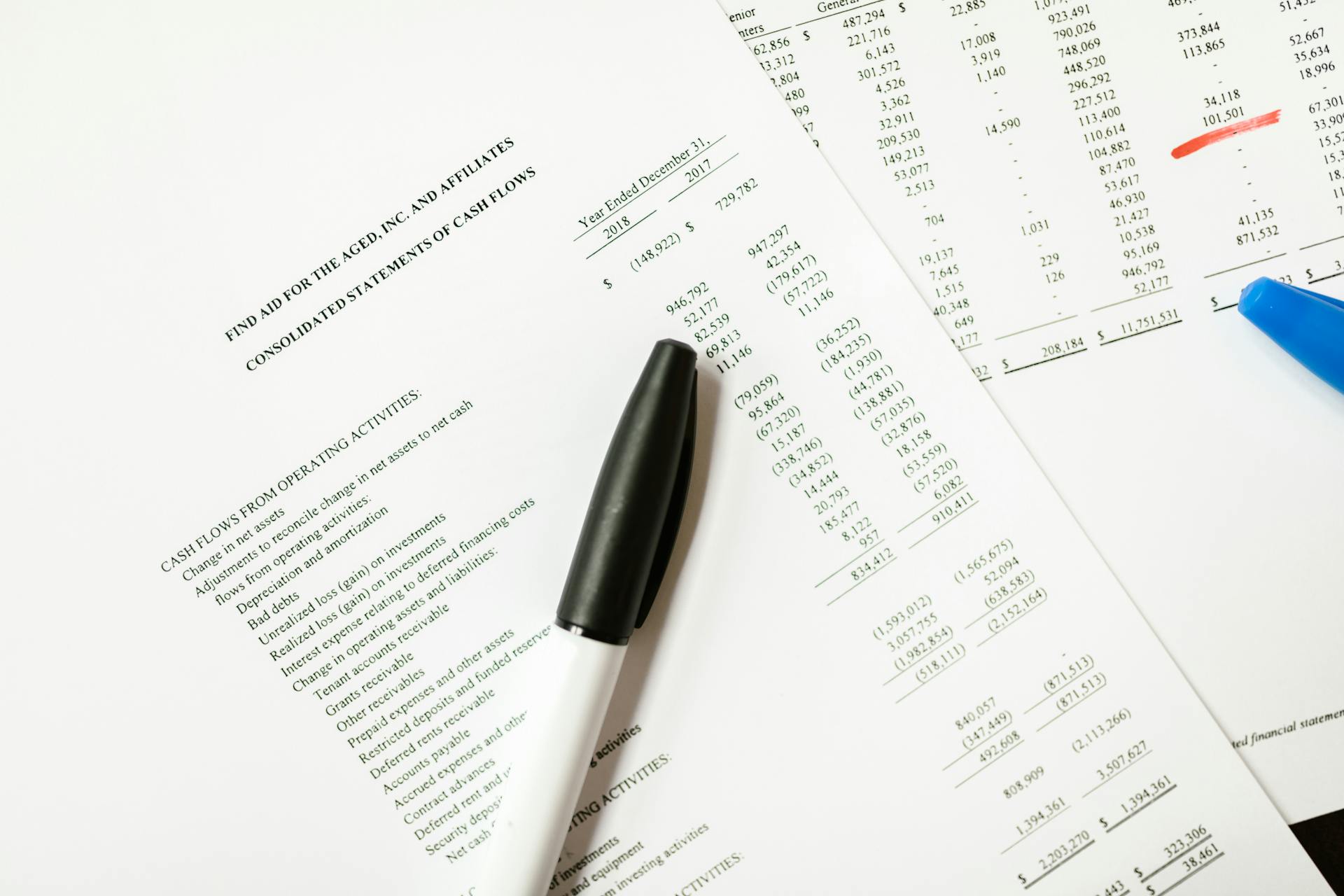
The cash conversion cycle is a critical metric for businesses to understand and optimize. It's the time it takes for a company to convert its investments in inventory and accounts receivable into cash.
A longer cash conversion cycle can indicate inefficiencies in a company's operations, such as slow inventory turnover or ineffective credit management. This can lead to cash flow problems and hinder business growth.
To improve the cash conversion cycle, businesses can focus on reducing the days inventory outstanding (DIO) by implementing just-in-time inventory management and optimizing inventory levels. By doing so, they can free up cash that would have been tied up in inventory.
By streamlining their operations and improving their cash conversion cycle, businesses can improve their cash flow and make more informed decisions about investments and growth initiatives.
A fresh viewpoint: Free Cash Flow Cash Flow from Operations
Calculating the Cash Conversion Cycle
To calculate the cash conversion cycle, you'll need to gather three key values: Days Inventory Outstanding (DIO), Days Sales Outstanding (DSO), and Days Payable Outstanding (DPO).
Check this out: Days Sales Outstanding
DIO measures the number of days it takes to turn inventory into sales, with a lower number indicating faster sales. For example, Company A took approximately 18 days to turn its inventory into sales.
DSO, on the other hand, measures the number of days it takes to collect cash from sales. A lower DSO value is desirable, as it indicates faster cash collection. Company A collected its cash in approximately 15 days.
To calculate DPO, you'll need to determine the average number of days it takes to pay suppliers. A higher DPO value is desirable, as it indicates favorable terms and efficient cash utilization.
The cash conversion cycle formula is: Cash Conversion Cycle = DIO + DSO - DPO. You can use the following formula to calculate each value:
- DIO = Average Inventory / COGS Per Day
- DSO = Average Accounts Receivable / Revenue Per Day
- DPO = Average Accounts Payable / COGS Per Day
Here's a breakdown of the formula:
By understanding and calculating these three values, you'll be able to determine your company's cash conversion cycle and identify areas for improvement.
Interpreting the Cash Conversion Cycle
The cash conversion cycle is a measure of how efficiently a company manages its working capital, and the shorter the cycle, the better the company is at selling inventories and recovering cash from these sales while paying suppliers.
To get a clear picture of a company's cash conversion cycle, you need to compare it to companies operating in the same industry, and also track it over time to see if it's improving or deteriorating.
Measuring a company's conversion cycle to its cycles in previous years can help you gauge whether its working capital management is deteriorating or improving.
Comparing the cycle of a company to its competitors can help determine whether the company's cash conversion cycle is "normal" compared to industry competitors.
The cash conversion cycle can be trended and compared to businesses in the same sector to see if a company's working capital management is improving or worsening.
If a company's cash conversion cycle is improving, it's likely that the company is becoming more efficient at managing its working capital, which can lead to more sales and profits.
A company's cash conversion cycle is made up of three components: inventory, accounts payable, and accounts receivable, and tracking these components can help you understand the company's cash management.
Recommended read: Average Cash Conversion Cycle by Industry
Improving the Cash Conversion Cycle
A higher cash conversion cycle can be a major obstacle to cash flow, but there are ways to improve it. You can make adjustments to move inventory more quickly, convert accounts receivable faster, adjust accounts payable terms, and automate accounts receivable.
By implementing these strategies, you can significantly shorten your cash conversion cycle. For example, a company can reduce its cash conversion cycle by accelerating its accounts receivable collections, which can bring in cash faster.
Here are some specific ways to improve your cash conversion cycle:
- Move inventory more quickly to reduce holding costs and free up cash.
- Automate accounts receivable to improve accuracy and efficiency.
- Adjust accounts payable terms to give you more time to make payments.
By implementing these strategies, you can improve your cash conversion cycle and increase your cash flow.
What Is DPO?
DPO measures the average number of days it takes a company to pay its invoices from trade creditors, or suppliers.
The formula for days payable outstanding is used to calculate this average number of days.
It takes Company A approximately 13 days to pay for its invoices, according to its fiscal year ended 2018.
This means that Company A pays its suppliers in about two weeks.
Intriguing read: Is It Cheaper to Have Dental Insurance or Pay Cash
Using Datarails for Budgeting and Forecasting
Using Datarails for Budgeting and Forecasting can be a game-changer for finance teams. Datarails' FP&A software replaces spreadsheets with real-time data.
Every finance department knows how tedious building a budget and forecast can be. Integrating cash flow forecasts with real-time data and up-to-date budgets is a powerful tool that makes forecasting cash easier.
Worth a look: Cash Flow Forecasting
How to Improve
Improving the cash conversion cycle requires a multi-faceted approach. You can make adjustments to inventory management, sales realization, and payables to reduce your cycle.
Moving inventory more quickly is a great place to start. This can be achieved by implementing efficient inventory management practices, such as just-in-time ordering and minimizing stockouts.
A higher inventory turnover rate is a positive indicator of a company's efficiency. If your inventory turnover is higher than your industry peers, it's a sign that you're doing something right.
To improve your cash conversion cycle, consider the following adjustments:
- Move inventory more quickly
- Convert accounts receivable faster
- Adjust accounts payable terms
- Automate accounts receivable
Accelerating accounts receivable collections is a key strategy for reducing the cash conversion cycle. This can be achieved by automating accounts receivable, implementing collections email templates, and optimizing the AR cycle.
Accounts receivable automation can have a significant impact on cash flow. By automating the process, you can reduce errors, get paid faster, and collaborate with customers more efficiently.
Adjusting accounts payable terms can also give you more flexibility and time to make payments. However, this should be done with caution, as suppliers generally prefer businesses that pay faster and on time.
Financial Impact of the Cash Conversion Cycle
A longer Cash Conversion Cycle (CCC) can be a major financial burden, as it means a company takes longer to generate cash. This is because a longer CCC indicates that a company is collecting payments slowly, overestimating inventory needs, or paying its bills too quickly.
Collecting payments quickly can have a significant impact on a company's cash flow. If a company collects payments quickly, it shortens the CCC, meaning it can generate cash more efficiently.
Investors pay close attention to a company's CCC value, as it can indicate how quickly a company can generate returns. If two companies have similar return on equity (ROE) and return on assets (ROA) values, investors may choose the company with the lowest CCC value.
Broaden your view: The Current Ratio Measures a Company's
A shorter CCC is a sign of a healthier company, as it indicates that management is using short-term assets and liabilities efficiently to generate cash. This also gives a peek into the company's financial health concerning cash management.
The CCC value helps assess the liquidity risk linked to a company's operations, making it a crucial metric for investors and analysts.
Frequently Asked Questions
What is the cash conversion cycle?
The cash conversion cycle is a key financial metric that measures how long it takes for a company to turn its inventory into cash through sales. It's calculated by combining days inventory outstanding, days sales outstanding, and days payable outstanding.
What is the formula for CCC?
The formula for Cash Conversion Cycle (CCC) is: DIO + DSO - DPO. This calculation helps businesses understand how long it takes for their cash to be converted into sales.
Is a higher or lower cash conversion cycle better?
A lower cash conversion cycle is generally better, as it indicates a company is more efficient and responsive to market conditions. A shorter CCC can signal a company's ability to quickly convert inventory into cash, reducing liquidity risks.
What does a high CCC mean?
A high Cash Conversion Cycle (CCC) indicates that a company takes a long time to turn its inventory investments into cash, increasing its risk of insolvency. This can be a warning sign for small businesses with CCCs extending beyond 60-90 days.
What is the difference between cash conversion cycle and working capital days?
While working capital days measures the time it takes to sell inventory and collect accounts receivable, the cash conversion cycle specifically calculates the time it takes to turn inventory into cash, including accounts payable. In essence, cash conversion cycle is a more comprehensive metric that considers the entire working capital cycle.
Sources
- https://corporatefinanceinstitute.com/resources/accounting/cash-conversion-cycle/
- https://www.versapay.com/resources/what-is-the-cash-conversion-cycle
- https://www.datarails.com/finance-glossary/cash-conversion-cycle-formula/
- https://fincent.com/glossary/cash-conversion-cycle
- https://www.investopedia.com/terms/c/cashconversioncycle.asp
Featured Images: pexels.com


